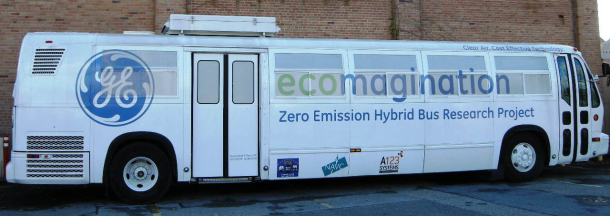
When it comes to buses, a group of researchers say two batteries based on different technology are better than one large battery. The Federal Transit Authority (FTA) Hybrid Transit Bus project team, which GE scientists are a part of, has built a hybrid electric bus by loading it with one high-power lithium ion battery and one high-energy density sodium battery, GE Global Research, GE‘s research arm, announced today.
Lithium batteries can provide bursts of power, but don’t have much capacity. Sodium batteries, meanwhile, can store more energy, but can’t provide those bursts of power necessary to propel something like a giant bus. Installing each type of battery in one system solves this power versus driving-range issue, according to GE.
The story behind how the research team came up with the idea to implement this type of battery technology has been detailed in a blog post written by Lembit Salasoo, senior electrical engineer and principal investigator of the FTA Hybrid Transit Bus project. “Right now, our bus has a top speed of 50 mph and about a 60-80 mile range under idealized conditions. The ultimate target is 62 mph and a real-life 100-mile range, while travelling a transit bus route with its multiple stops and starts,” wrote Salasoo.
The 100-mile mark is key as the team has determined that average municipal and school buses in the U.S. only travel up to 100 miles per day and the dual-battery system is also less expensive than using a scaled-up size lithium ion battery to gain more energy capacity, which is one of the other ideas that have been tossed around in research circles, according to Salasoo.
“Unlike a single battery, you wouldn’t have to over-size your single battery to compensate for more storage or power. Additionally, the dual battery can incorporate less expensive battery chemistries into your battery system. According to modelling studies we have done, these attributes could help reduce the cost of your battery by up to 20%,” he wrote.
The dual-battery drive train can be applied to delivery trucks and heavy-duty vehicles as well as buses, but other work will need to be done before it could be applicable for use in electric cars, according to Salasoo.
GE is partnering on the research with the U.S. Federal Transit Administration and Northeast Advanced Vehicle Consortium through a $13 million research project funded by the National Fuel Cell Bus Program. With a lot of government grants and investment backing them, municipal and school buses has been a testing ground for many different types of alternative-fuel drive trains.
A lot of hydrogen-based technology, for example, has been tested on municipal buses. U.S. school bus manufacturer Navistar began making hybrid and electric school buses after receiving $39 million federal funds to develop and manufacture alternative-fuel vehicles in Elkhart County, Ind. In May it was announced that some Ohio and Wisconsin students will soon be riding hybrid buses made possible in large part through a U.S. government grant to replace existing school buses with more efficient options.



